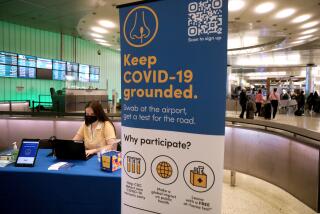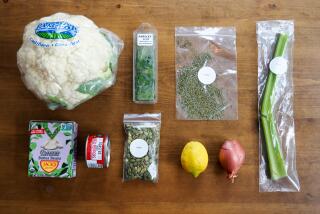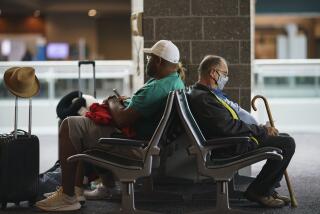Cholera Represents a Distant but Real Danger : Exercising precautions can help minimize risk, even in countries where the disease is present.
- Share via
The risk of contracting cholera is a remote but real one for international travelers--a fact brought home, literally, last month when 76 out of 336 passengers on a flight from South America to Los Angeles were felled by cholera that eventually killed one man. Most of the affected passengers became ill within days, some within hours, and eight people were admitted to Los Angeles County hospitals, some for as long as five days.
After the nature of the problem aboard the Aerolineas Argentinas flight from Buenos Aires and Peru became evident, a Los Angeles county health team swung into action, pinpointing a 13-ingredient seafood salad as the source of contamination. (The medical investigators got an important clue that passengers had become infected on the plane, not abroad, when they learned that a ground crew employee came down with cholera after sneaking food from the aircraft.)
Epidemic in many areas of South America, cholera is caused by an intestinal infection by the bacterium Vibrio cholerae , which generally is contracted by consuming contaminated food, water or drink. In a cholera epidemic, the usual source of contamination is the feces of an infected person and often can be traced back to water sources polluted by sewer systems. The infection can be spread by food prepared with polluted water, ice made from polluted water, the water itself or seafood that has lived in the water. Since cooking to internal temperatures of 140 degrees can kill the bacteria, cooked food is generally safer than raw, but freezing does not kill the bacteria. The United States generally is spared from cholera because it has proper drinking and sewage treatment, according to the Centers for Disease Control in Atlanta. But even healthy, fit Americans can become infected.
In the wake of the Aerolineas Argentinas experience, county health officials are advising that travelers who exercise reasonable precautions can minimize their risk of cholera. And airline officials say they have dropped risky foods from menus on international flights and stepped up bacteriological testing of food and drink. Careful selection of food and drink while visiting cholera-stricken areas can further reduce the risk of contracting the potentially lethal bacterial infection, health experts say.
“What occurred with this outbreak is very unusual,” said Dr. Shirley Fannin, director of disease control for Los Angeles County’s Department of Health Services. In fact, Fannin said, it is the only airline-related cholera outbreak she recalls in her 16 years on the job. Yet, it is prompting a few changes.
“Airlines have taken a fresh look at their food services” in an effort to make cholera transmission aloft an even more remote possibility, Fannin said.
“We have removed all fresh salads and seafood entrees (from) flights departing South America,” said Lise Olson, a spokeswoman for American Airlines. “We are in the process of making a public announcement to explain these menu differences. We are encouraging food handlers to report sickness or diarrhea. We have weekly bacteriological testing of food and are also sampling ice for bacteria. We are trying to reinforce what our guidelines already address.”
Aerolineas Argentinas is taking similar precautions, said spokeswoman Lou Ann Lebon. The airline no longer serves “fresh fruits, uncooked vegetables, seafood or cream cheese,” she said. And extra precautions are being taken to prevent contamination of drinks and ice.
People can be infected and not notice any symptoms, experts say. “Well over 50% of people (on the Peru-to-Los Angeles flight) did not have any symptoms at all,” Fannin said. In others, the illness may have begun as a painless diarrhea without abdominal cramps or fever, according to experts at the CDC.
It can take 1 million cholera bacteria to produce severe diarrhea in healthy people, said CDC medical epidemiologist Dr. J. Todd Weber. But a single shrimp can contain a million bacteria, according to Dr. Abram Benenson, a cholera expert at San Diego State University. About 1 in 20 people infected will have severe disease, marked by watery diarrhea, vomiting and leg cramps.
Prompt medical treatment is crucial for those with severe symptoms. Cholera can kill by dehydration in as few as two hours, warn two CDC physicians in a recent Journal of the American Medical Assn. article. “In severe cholera, rapid replacement of fluids and electrolytes is the only way to save lives,” write Drs. David Swerdlow and Allen Ries. The treatment is called rehydration therapy, in which fluids are given orally or intravenously. Antibiotics can also be given to shorten the duration of illness.
A vaccine against cholera is available, but it is not recommended by the CDC or many cholera experts. The duration of protection is only three to six months. So a traveler would have to predict exposure, which is almost impossible, Benenson notes. The vaccine also tends to give people a false sense of security, he said, and they may become lax about what they ingest. Other vaccines are under study.
Cholera most often strikes those who “break the rules,” Fannin notes, giving as an example: “people who eat from food carts out on the street in foreign countries.” Food handlers who don’t practice good hygiene can transmit the disease. Commercially packaged food sold from a cart is safer, assuming the traveler is the one to open the package, she said.
“Food that is handled by human hands and not subsequently cooked has to be considered a risk,” said Fannin, citing fresh fruit and green salads as poor dining choices in cholera-stricken areas. “Unless you know those people were wearing gloves while preparing the food. The more the handling, the worse the risk. As long as there is no handling after the cooking, it should be safe.”
“Eat hot food,” Benenson suggested. “Carbonated drinks are safe. But skip the ice.”
Extra vigilance is a good idea when traveling with children, Fannin said. “Young kids probably get infected at a lower dose (of bacteria). So I wouldn’t feed them raw or undercooked anything from an area of the world having cholera.”
Fear of cholera shouldn’t ground travelers, Fannin insists. “If I wanted to go (to a cholera-stricken area), all I would do is make sure I was comfortable with my source of water and food.”
The best rule, according to CDC physicians Swerdlow and Ries, is: “Boil it, cook it, peel it or forget it.”
For people traveling to South and Central America, the Centers for Disease Control maintains an international travelers’ hot line to answer questions about disease and vaccination. Information is available in English at (404) 332-4559 and in Spanish at (404) 330-3132.
More to Read
Sign up for The Wild
We’ll help you find the best places to hike, bike and run, as well as the perfect silent spots for meditation and yoga.
You may occasionally receive promotional content from the Los Angeles Times.






